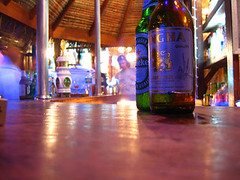 I shadowed a third year fellow in the cardiac cath lab today, watching two interventional procedures. The first was the expansion of a stenotic bicuspid aortic valve and the second was the closure of an atrial septal defect (ASD).
I shadowed a third year fellow in the cardiac cath lab today, watching two interventional procedures. The first was the expansion of a stenotic bicuspid aortic valve and the second was the closure of an atrial septal defect (ASD).
Note: The cath lab pictured is at Columbus Children's, not where I work. They look the same, though.
During the first case it took almost two hours to get access - meaning to establish a catheter in a femoral artery and femoral vein. In this case it was important to have both because we wanted to measure the blood pressure in the left ventricle and in the aorta. Ideally there is no difference; in our patient there was a 100 mm Hg gradient. This indicates that the aortic valve is very stenotic (narrow) - a condition that eventually requires a valve replacement. Valve replacements in children are to be avoided so there are two ways to buy some time: 1) expand the valve with a balloon in a catheter procedure or 2) open the chest and scrape the valve in surgery. The procedures carry approximately the same rate of complication, but each carries a different complication. Surgery generally leaves residual stenosis and interventional radiology tends to produce aortic insufficiency (backwards flow through the valve from the aorta into the ventricle).

The second case involved using a yo-yo looking instrument to plug a hole in the septum separating the two atria. If you look closely at the picture to the right you can see it in the top, just right of center. Once the catheter enters the heart, it is threaded through the hole (technically called a patent forman ovale, patent indicating open) and the first half of the yo-yo is deployed. The catheter is retracted through the hole and the second half of the yo-yo is deployed. It's very important that the placement is correct because otherwise it could loosen and go bumping around the heart or even enter the systemic circulation (depending on the size and type of closure device used).
Interestingly, you cannot actually see the outlines of the heart when doing a cath procedure. All the monitors carry continuous x-ray images and if you've seen an x-ray before you know that it's nearly impossible to see tissue with any resolution. That's how well these guys know the heart. They can tell by the ribs and chest cavity around it exactly where they are inside it. When appropriate, they will use a simultaneous ultrasound though (on which you can see tissue and blood flow).
At the end of the day, I'm not sure this is my new specialty of choice. It was incredibly cool to see and the people who work in the group were really fun (the atmosphere resembled a sports team pre and post game), but the patients are sedated the whole time you are with them and man, those lead aprons/vests/thyroid glands are heavy and hot!
 For the last few weeks this little academic turned into a little socialite. There was tennis, bruchetta, wine, rum runners, bread pudding and strolls though the park. I'm hoping the tennis will continue, and I may be adding in yoga too.
For the last few weeks this little academic turned into a little socialite. There was tennis, bruchetta, wine, rum runners, bread pudding and strolls though the park. I'm hoping the tennis will continue, and I may be adding in yoga too.



